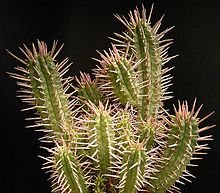
Aloe is a genus containing over 650 species of flowering succulent plants. The most widely known species is Aloe vera, or "true aloe". It is called this because it is cultivated as the standard source for assorted pharmaceutical purposes. Other species, such as Aloe ferox, are also cultivated or harvested from the wild for similar applications.

Datura is a genus of nine species of highly poisonous, vespertine-flowering plants belonging to the nightshade family (Solanaceae). They are commonly known as thornapples or jimsonweeds, but are also known as devil's trumpets. Other English common names include moonflower, devil's weed, and hell's bells. All species of Datura are extremely poisonous and potentially psychoactive, especially their seeds and flowers, which can cause respiratory depression, arrhythmias, fever, delirium, hallucinations, anticholinergic syndrome, psychosis, and death if taken internally.

Euphorbia is a very large and diverse genus of flowering plants, commonly called spurge, in the family Euphorbiaceae. "Euphorbia" is sometimes used in ordinary English to collectively refer to all members of Euphorbiaceae, not just to members of the genus.
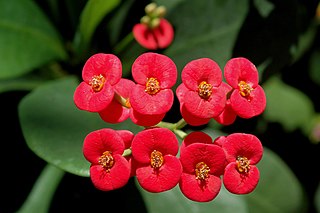
Euphorbia milii, the crown of thorns, Christ plant, or Christ's thorn, is a species of flowering plant in the spurge family Euphorbiaceae, native to Madagascar. The species name commemorates Baron Milius, once Governor of Réunion, who introduced the species to France in 1821.
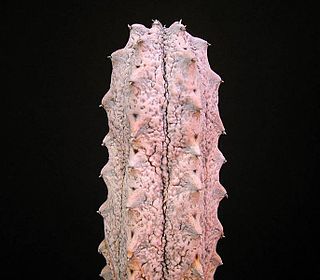
Euphorbia abdelkuri is a species of plant in the family Euphorbiaceae. It is endemic to Abd al Kuri, an island south of Yemen. Its natural habitat is rocky areas. The Latex of the plant is toxic.

Euphorbia ambovombensis is a species of plant in the family Euphorbiaceae. It is endemic to Madagascar. It is native to the area around Ambovombe at the southern end o the island, where it is locally common. Its natural habitats are subtropical or tropical dry forests and subtropical or tropical dry shrubland. It is threatened by habitat loss.
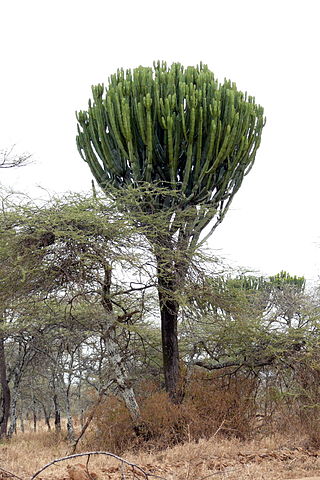
Euphorbia candelabrum is a succulent species of plant in the family Euphorbiaceae, one of several plants commonly known as candelabra tree. It is endemic to the Horn of Africa and eastern Africa along the East African Rift system. It is known in Ethiopia by its Amharic name, qwolqwal, or its Oromo name, adaamii. It is closely related to three other species of Euphorbia: Euphorbia ingens in the dry regions of southern Africa, Euphorbia conspicua from western Angola, and Euphorbia abyssinica, which is native to countries including Sudan, Eritrea, Djibouti, Ethiopia and Somalia.

Andranomena Special Reserve is a wildlife reserve in Menabe Region, western Madagascar, near the city of Morondava and the rural commune of Bemanonga.

Euphorbiaceae, the spurge family, is a large family of flowering plants. In English, they are also commonly called euphorbias, which is also the name of the type genus of the family. Most spurges, such as Euphorbia paralias, are herbs, but some, especially in the tropics, are shrubs or trees, such as Hevea brasiliensis. Some, such as Euphorbia canariensis, are succulent and resemble cacti because of convergent evolution. This family has a cosmopolitan global distribution. The greatest diversity of species is in the tropics; however, the Euphorbiaceae also have many species in nontropical areas of all continents except Antarctica.
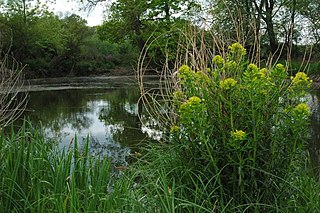
Euphorbia palustris, the marsh spurge or marsh euphorbia, is a species of flowering plant in the family Euphorbiaceae, native to marshland throughout much of mainland Europe and western Asia. It is an herbaceous perennial growing to 90 cm (35 in) tall and wide, with narrow leaves turning red and yellow in autumn, and persistent, bright acid yellow flower-heads (cyathia), 15 cm (6 in) across, in spring.
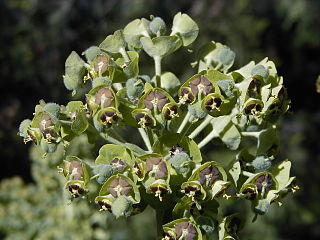
Euphorbia characias, the Mediterranean spurge or Albanian spurge, is a species of flowering plant in the family Euphorbiaceae typical of the Mediterranean vegetation. It is an upright, compact evergreen shrub growing to 1.2 m tall and wide.

Euphorbia caput-medusae is a plant of the genus Euphorbia that occurs in and around Cape Town, South Africa.

Euphorbia antiquorum, known as antique spurge and "Euphorbia of the Ancients", is a species of succulent plant in the family Euphorbiaceae. It is widespread throughout peninsular India, but its wild origin is obscure. Escaped or naturalized and widely cultivated in neighbouring regions, such as Burma, China, Bangladesh, India, Indonesia, Iran, Malaysia, Myanmar, Pakistan, Thailand, the Philippines, Sri Lanka, and Vietnam, and in many tropical zones worldwide.
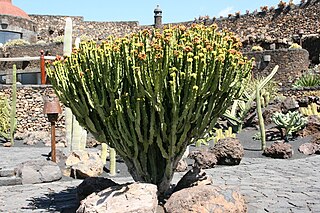
Euphorbia abyssinica, commonly known as the desert candle or candelabra spurge, is a species of plant in the family Euphorbiaceae. E. abyssinica is endemic to Ethiopia, Somalia, Sudan and Eritrea. It was first described in 1791, by the German botanist Johann Friedrich Gmelin. In its native habitat, it can grow up to 10 m (33 ft) tall. The woody stem is used for firewood and as timber in roofing, furniture and other items, and the sap is used in traditional medicine. It is also cultivated as an ornamental house plant.
Euphorbia aleppica is a species of plant in the family Euphorbiaceae.

Euphorbia actinoclada is a species of plant in the family Euphorbiaceae. It is endemic to Kenya, Somalia, and Ethiopia. As most other succulent members of the genus Euphorbia, its trade is regulated under Appendix II of CITES.
Euphorbia apios is a species of plant in the family Euphorbiaceae.
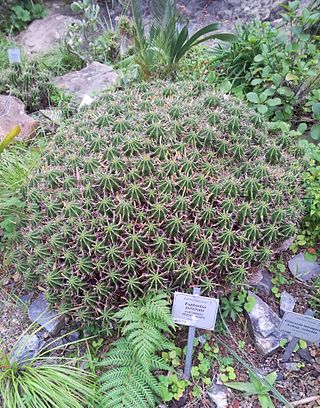
Euphorbia pulvinata, commonly known as the pincushion euphorbia, is a species of plant in the family Euphorbiaceae native to southern Africa.
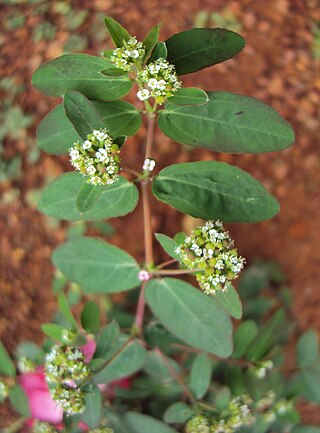
Euphorbia hypericifolia is a species of perennial herb in the genus Euphorbia native to tropical Americas. It normally grows up to 2 feet (0.6 m) in height, and contains milky sap which can cause skin and eye irritation.
